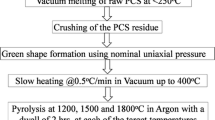Abstract
In this study, the parameters which influence strength of the open-cell reaction bonded silicon nitride foams were investigated. These parameters include the monomer content in the suspension, the porosity level of the foam, the nitriding atmosphere including N2 and N2–4 %H2, and the nitriding temperature ranging from 1350 to 1425 °C. The nitriding mechanisms dominating under different nitriding conditions were also studied based on the phase and microstructural analysis. It was observed that there is a minimum monomer concentration of 25 wt% required in the premix solution to obtain a defect-free and homogeneous RBSN foam. Increasing the monomer content only from 15 to 20 wt% resulted in a threefold increase in the foam strength. The high porosity level of the foam which is above 70 vol% significantly affects the nitriding mechanisms and microstructures compared to those of dense RBSN ceramics. The maximum strength was obtained for the foams nitrided under N2–H2 atmospheres, and the nitriding temperature had a negligible effect on the foam strength when H2 is present in the atmosphere. α-Si3N4 is also the dominant phase in the microstructure in the presence of H2 regardless of the nitriding temperature. It was observed that β-Si3N4 can also be present in high quantities when N2 atmospheres are used. β-Si3N4 is present in the microstructures in two different morphologies including interlocking rods and angular grains. Each morphology forms based on a specific nitriding mechanism.














Similar content being viewed by others
References
Pigeon R, Varma A, Miller A (1993) Some factors influencing the formation of reaction-bonded silicon nitride. Mater Sci 28:1919–1936
Huang Y, Zhou L, Tang Q, Xie Z, Yang J (2001) Water-based gelcasting of surface-coated silicon nitride powder. Am Ceram Soc 84(4):701–707
Laarz E, Zhmud BV, Bergstrom L (2000) Dissolution and deagglomeration of silicon nitride in aqueous medium. Am Ceram Soc 83(10):2394–2400
Omatete O, Strehlow R, Walls C (1990) Gelcasting of submicron alumina, sialon, and silicon nitride powders. In: The 37th sagamore army materials research, Plymouth
Alem A, Pugh MD, Drew RA (2014) Open-cell reaction bonded silicon nitride foams: fabrication and characterization. J Eur Ceram Soc 34(3):599–609
Moulson A (1979) Review: reaction-bonded silicon nitride: its formation and properties. Mater Sci 14:1017–1051
Lindley M, Elias D, Jones BF, Pitman K (1979) The influence of hydrogen in the nitriding gas on the strength, structure and composition of reaction-sintered silicon nitride. Mater Sci 14:70–85
Dalgleish B, Pratt P (1975) The Influence of Microstructure on the Strength of Reaction-Bonded Silicon Nitride. Mech Prop Ceram 2(25):295–310
Evans AG, Davidge RW (1970) The strength and oxidation of reaction-sintered silicon nitride. Mater Sci 5:314–325
Gazzara CP, Messier DR (1977) Determination of phase content of Si3N4 by X-ray difraction Analysis. Am Ceram Soc Bull 56(9):777–780
Ziegler G, Heinrich J, Wotting G (1987) Relationships between processing, microstructure and properties of dense and reaction-bonded silicon nitride. Mater Sci 22:3041–3086
Jennings H (1983) Review: on reactions between silicon and nitrogen Part 1: Mechanisms. Mater Sci 18:951–967
Danforth S, Jennings H, Richman M (1979) The influence of microstructure on the strength of reaction bonded silicon nitride(RBSN). Acta Metall 27:123–130
Jennings HM, Dalgleish BJ, Pratt PL (1988) Reactions between silicon and nitrogen; Part 2 Microstructure. Mater Sci 23:2573–2583
Petzow G, Herrmann M (2002) Silicon nitride ceramics. High Perform Non Oxide Ceram II 102:47–167
Atkinson A, Leatt P, Moulson A, Roberts E (1974) A mechanism for the nitridation of silicon powder compacts. Mater Sci 9:981–984
Acknowledgements
The authors gratefully acknowledge the financial assistance provided by National Science and Engineering Research Council of Canada.
Author information
Authors and Affiliations
Corresponding author
Rights and permissions
About this article
Cite this article
Alem, A., Drew, R.A.L. & Pugh, M.D. The influence of the nitriding parameters on the microstructure and strength of the open-cell reaction bonded silicon nitride foams fabricated via wet processing. J Mater Sci 49, 4780–4789 (2014). https://doi.org/10.1007/s10853-014-8177-4
Received:
Accepted:
Published:
Issue Date:
DOI: https://doi.org/10.1007/s10853-014-8177-4




